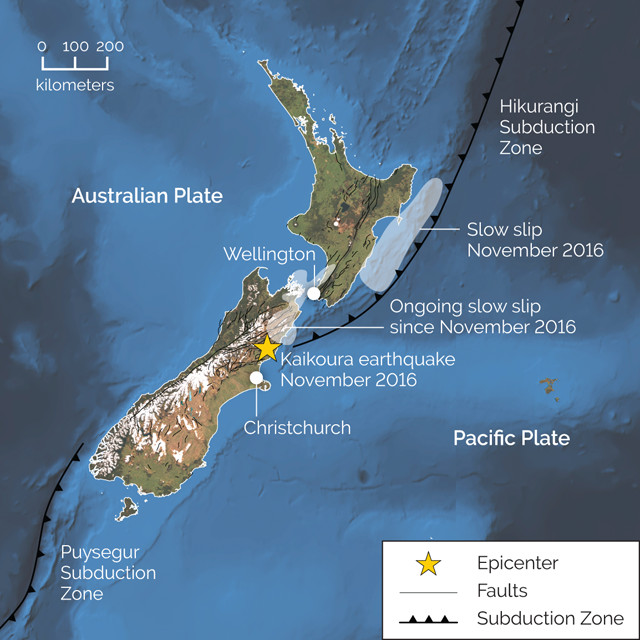
by Mary Caperton Morton Thursday, December 14, 2017

The 2016 Kaikoura earthquake set off slow-slip events off the east coast of New Zealand's North Island as well as beneath the country's capital, Wellington. Credit: K. Cantner, AGI.
On Nov. 14, 2016, a magnitude-7.8 earthquake struck near Kaikoura on New Zealand’s South Island, setting off a cascade of fault ruptures in the region. Within hours, seismic waves from the quake triggered a two-week-long slow-slip event on a section of the Hikurangi Subduction Zone between 250 and 600 kilometers north of the initial epicenter, as well as ongoing slow slip on the Hikurangi beneath New Zealand’s capital, Wellington, according to a new study in Nature Geoscience. Thanks to New Zealand’s advanced seismic and tectonic monitoring networks, the event is one of the best-documented examples of an earthquake triggering slow slip on distant faults.
Slow-slip events — essentially slow-motion earthquakes that produce fault movement but no discernible shaking at the surface — were first documented in 2001 along the Cascadia Subduction Zone off the Pacific Northwest coast of North America. Scientists have been working ever since to understand why some sections of faults slip slowly, without the violent shaking caused by earthquakes. “We’re still trying to figure out the physics behind why [slow slip] happens in some places and not others,” says lead author Laura Wallace, a geophysicist at the University of Texas at Austin and GNS Science in New Zealand. Currently, researchers suspect that fluids in the faults combined with certain frictional characteristics of the rocks may promote slow slip, she says.
In the new study, Wallace and her colleagues analyzed seismic and GPS data, finding that the 2016 Kaikoura quake set off a roughly two-week-long slow-slip event several hundred kilometers to the north on a shallow offshore section of the Hikurangi Subduction Zone, which runs beneath New Zealand’s North Island. The region of slow slip was less than 15 kilometers beneath the surface.
Slow slip was also triggered along a deeper section of the Hikurangi — about 30 to 40 kilometers deep — closer to the Kaikoura earthquake epicenter and just west of Wellington; this slip has been ongoing since the initial quake.
“This slow-slip event following the Kaikoura earthquake is the largest and most widespread episode of slow slip observed in New Zealand since [monitoring] instruments were installed in 2002,” Wallace says. Triggered slow slip has been observed before, elsewhere, but this episode is “one of the clearest and largest examples we’ve seen,” she says.
The slow slip in the north was probably triggered by rapid fluctuations in stress caused by the seismic waves passing through that area, Wallace says. “This tells us something about the strength of the fault where the slow slip was triggered: It must have been on the feather edge of failure.” Meanwhile, the ongoing slow slip near Wellington was more likely triggered by a direct, permanent change in stress brought on by the earthquake itself, she says. “Having two different types of triggering relationships is unique. It gives us an opportunity to think about all the ways that faults can communicate with one another.”
The lack of surface shaking from slow slip doesn’t mean there’s no danger associated with it, however. Movement along one section of fault may increase stress along another section, potentially pushing that section toward failure in the form of an earthquake, says John Vidale, a seismologist at the Southern California Earthquake Center and the University of Southern California who was not involved in the new study. “The big question now is: What does this mean for the capital of New Zealand?” Wellington, on the southern tip of the North Island, sits atop a locked section of the fault, and a strong quake could be disastrous for its 400,000 residents.
“If you have huge sections of fault that are shifting, redistributing stresses along the system, how does that change the hazard outlook for Wellington? It’s not an easy thing to quantify,” Vidale says. New Zealand has one of the best seismic and GPS monitoring networks in the world, but predicting exactly where, when and how severely a quake might strike is impossible. “All we can do is figure out the odds and try to prepare, but there’s always going to be a lot of uncertainly,” he says.
© 2008-2021. All rights reserved. Any copying, redistribution or retransmission of any of the contents of this service without the expressed written permission of the American Geosciences Institute is expressly prohibited. Click here for all copyright requests.